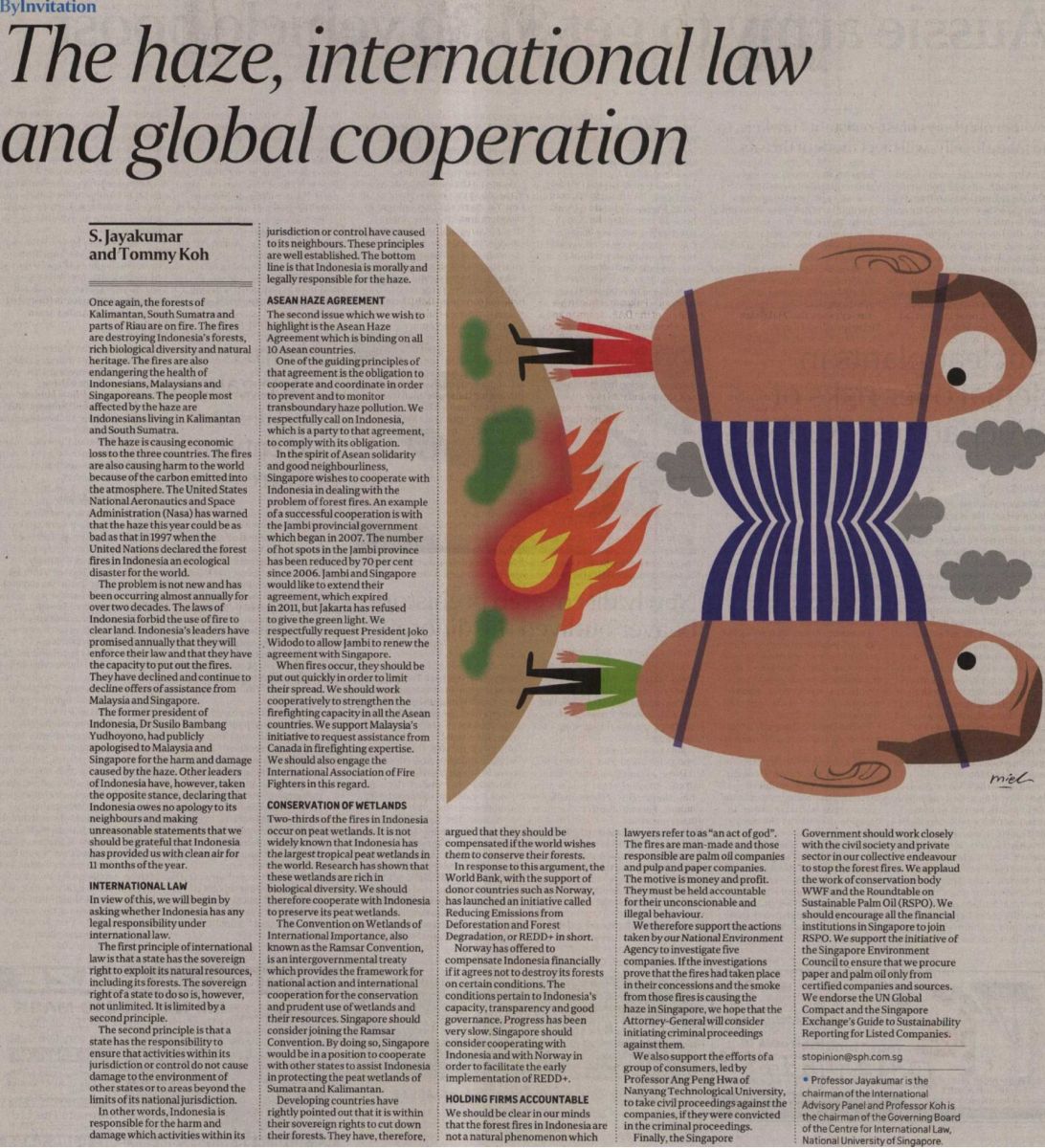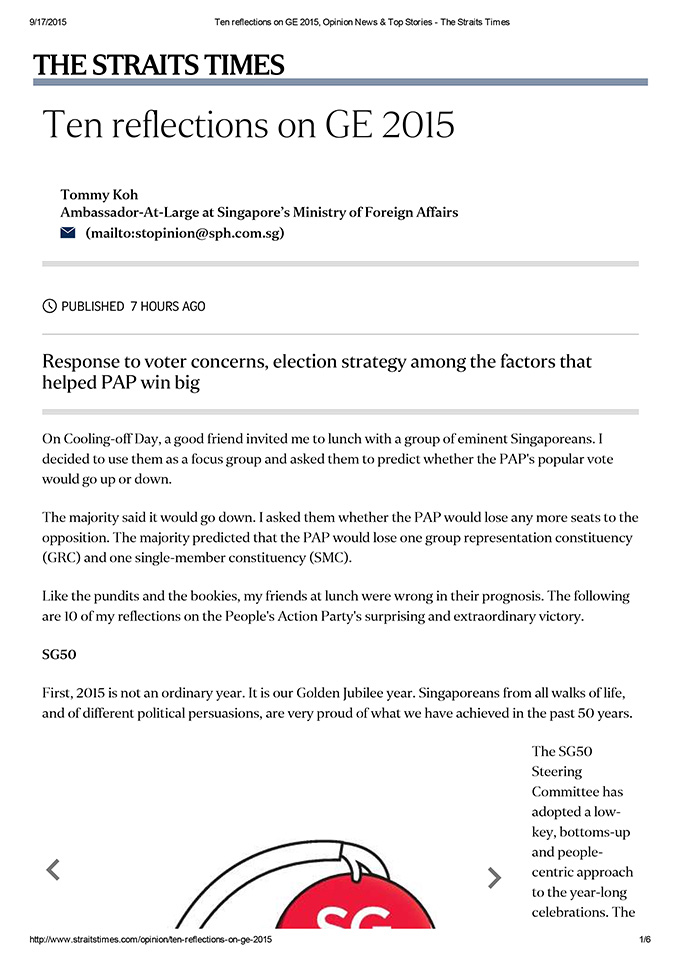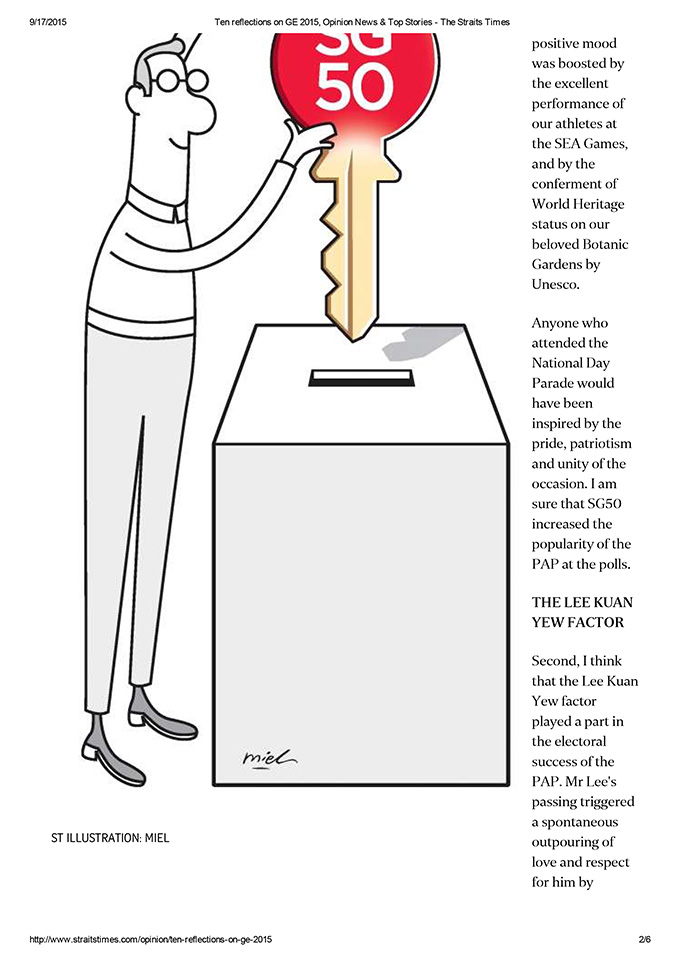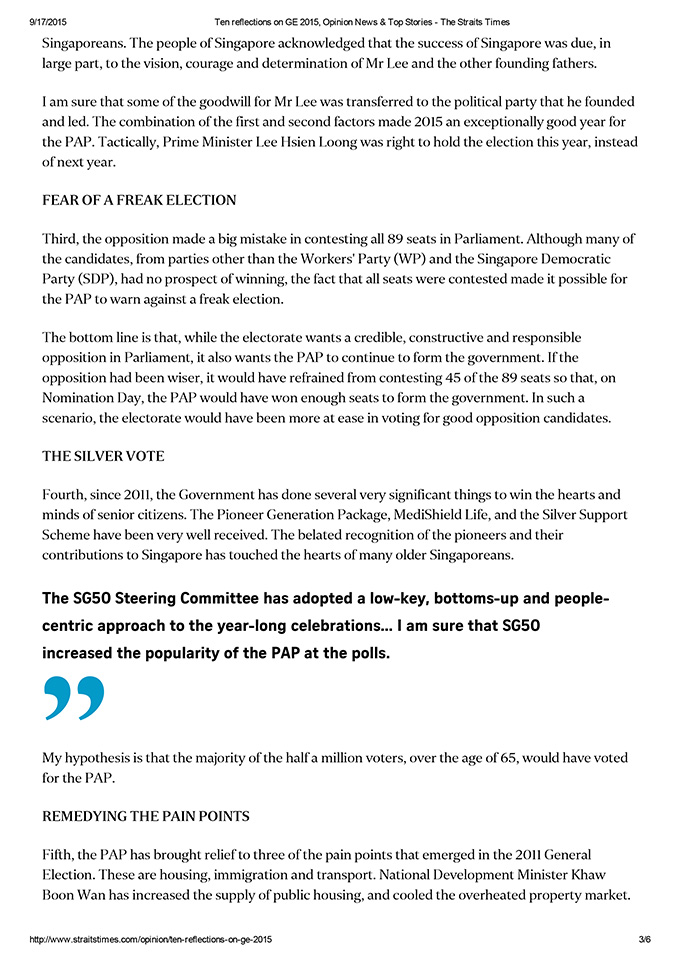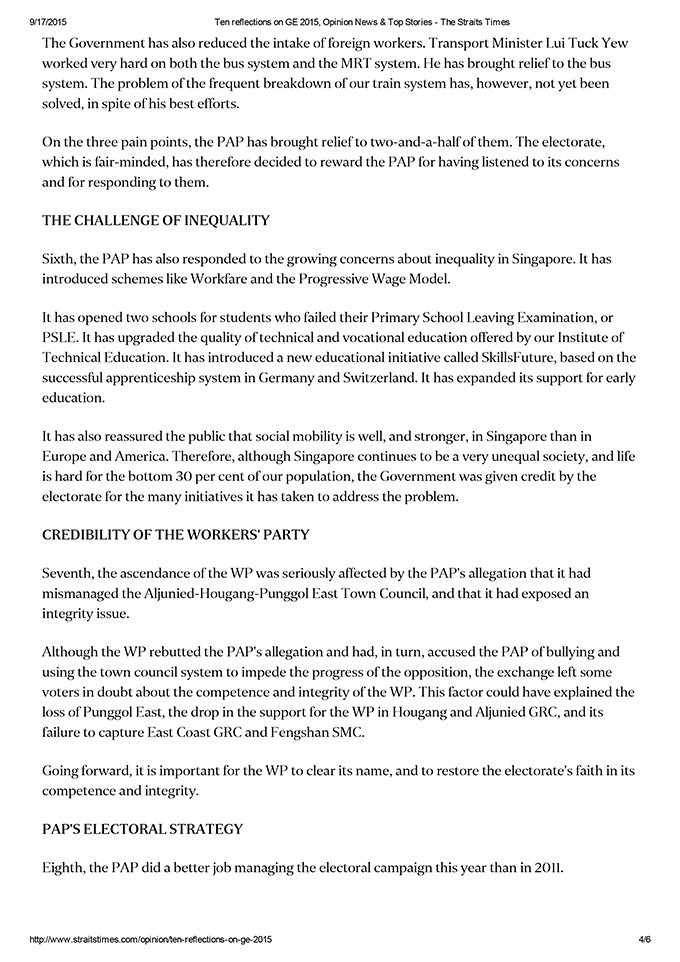Professor Tommy Koh’s speech at the annual lecture of the Singapore Medical Association
Salutations
Dr Wong Tien Hua, Professor Cheah Jin Seng, members of the medical profession, distinguished guests, ladies and gentlemen.
No Free Lunch
When Dr Wong requested me to deliver the SMA Lecture this year, I declined on the ground that I am not qualified to speak to members of the medical profession. Tien Hua’s mother, Professor Aline Wong, invited me to have lunch with her and her son. And as they say in America, there is no such thing as a free lunch and I was persuaded to change my mind whilst eating my chicken rice. I offered three possible topics for the lecture and both mother and son chose this one.
Similarities Between Doctors and Diplomats
I shall begin with my first point, which is that doctors and diplomats share some common traits and values. You can’t be a good doctor or a good diplomat if you do not like people. To succeed in our professions we must have empathy for people. We must have an open mind and be willing to treat people of different races, colours, religions, cultures with respect and as fellow human beings. To be a good doctor, you have to establish a rapport with your patient and gain his trust and confidence. The doctor-patient relationship becomes dysfunctional when the patient dislikes his doctor or has no confidence in him. I have no empirical evidence to support my hypothesis that a patient’s positive attitude towards his doctor contributes a significant percentage to the success of the healing process. My hypothesis is that a patient’s trust in his doctor is a key to recovery.
In a similar way, a good diplomat is able to establish a rapport with his interlocutor. He should try to raise the level of their relationship to one of friendship, based upon mutual trust and confidence. I have undertaken many negotiations, on behalf of Singapore and the United Nations. In all cases, I had tried to establish a warm relationship with my counterpart or interlocutors. This was particularly challenging when I was chairing the UN Conference on the Law of the Sea (1981-1982) and the Earth Summit (1990-1992) because they involved so many participating countries. However, I could not have pushed through some very tough decisions if I had not gained the trust of the conference participants.
Breakthrough In Moscow
Diplomats, unlike doctors, are a pretty cynical group of people. They have become cynical because they have seen so much evil and unprincipled policies and actions by states. Also, unlike doctors, diplomats are professional nomads and have to relocate themselves and their families, every few years, to a different country. In view of these facts, it would be reasonable to conclude that diplomats do not make good friends. This is, however, not the case.
Ambassador Tom Pickering
I want to tell you a story which I have never told in public before. In 1993, the then UN Secretary-General, Dr Boutros Boutros-Ghalli, had appointed me as his Special Envoy to undertake a peace mission to Russia, Estonia, Latvia and Lithuania. Towards the end of my mission, I called on an old friend, in Moscow, Ambassador Tom Pickering of the United States. I briefed him on my discussions in Moscow, Vilnius, Riga and Tallinn. He told me that, in Moscow, power was concentrated in the Kremlin and it was essential for me to have access to someone on the personal staff of President Boris Yeltsin. I told Amb Pickering that I had made a request to do so through the UN and the Singapore Embassy but was not successful. He told me that he would help me and he did. As a result, I was able to meet with a senior member of the President’s staff inside the Kremlin. I briefed him on my meetings in the four capitals and the compromises which I intended to propose in my report to the UN. I requested him to convey my respect to President Yeltsin and pleaded for his support.
Regional Medical Centre
I want to go on to my second point, which is Singapore’s role as the medical centre of the region. No one could dispute the fact that Singapore is the most advanced medical centre in Southeast, and perhaps, in the whole of Asia. A few years ago, a good friend from Iran, who lives in Hiroshima, needed surgery for her medical condition. Her Japanese doctor in Hiroshima recommended that she should go either to the US or Singapore for her treatment. She chose to come here.
Many of our region’s leaders come to Singapore for their annual medical check-up. When they fall ill, many of them have chosen to come here for treatment rather than go to the West. The high standing of our doctors and hospitals and the excellent care and services which they provide to patients in the region, bring credit to Singapore. It adds to our brand equity and soft power. It is good for our diplomacy with the region. We must never allow our love for money to undermine our reputation for integrity and trustworthiness.
Singapore and WHO
Third, I want to talk about Singapore’s relationship with the World Health Organisation (WHO). The WHO is the UN’s specialised agency for global health. In the year 2000, WHO ranked Singapore 6th out of 191 countries on overall health system performance. The WHO has designated 10 of our institutions as WHO Collaborating Centres, one of the highest in the Asia-Pacific region. These are research institutes, belonging to universities or academies, designated by WHO, to carry out activities in support of its programme.
SARS
In 2003, Singapore and several other countries in the region were hit by SARS. Singapore worked closely with WHO and the Centre for Disease Control (CDC) of the United States, to overcome the crisis. The two big lessons we learnt from that crisis were the importance of transparency and international cooperation. In 2006, Singapore was elected to the Executive Board of WHO for a three-year term. My dear friend and colleague, Dr Balaji Sadasivan, was elected chairman of the board for 2007-2008. His untimely passing from colon cancer was a great loss to Singapore.
Other Singaporeans, such as Dr Vernon Lee and Mr David Ho have also made significant contributions to the work of WHO. Dr Lee is currently the Head of the SAF Biodefence Centre. From 2007 to 2008, Dr Lee was a medical epidemiologist, working on Avian Influenza response and pandemic preparedness, in WHO’s office in Indonesia. From 2010 to 2012, he worked with the WHO, in Geneva, leading its work on global health collaborations and pandemic preparedness. I will talk about Mr David Ho’s work because he is not a doctor.
Humanitarian Medical Missions
Fourth, I want to refer to the fact that many Singaporean doctors, dentists, nurses, therapists and other allied professionals regularly go abroad on humanitarian medical missions. I was privileged to have been invited to deliver the keynote speech at the inaugural international conference on Humanitarian Medical Missions, held on 30 October 2014, at the Singapore General Hospital.
SIF and SAF
In my speech, I praised the work of four of our institutions, namely, the Singapore International Foundation, the Singapore Armed Forces, the Singapore Red Cross Society and Mercy Relief. To-date, SIF has undertaken 76 healthcare projects in 14 countries. The Singapore Armed Forces has a tradition of sending medical teams to help in emergency situations. The Singapore Red Cross Society and Mercy Relief have also despatched volunteer medical teams to help in humanitarian emergencies.
I am proud to say that our public hospitals support volunteerism as part of their corporate social responsibility. Members of the staff are encouraged to volunteer their time, in both local and international projects. A staff member is allowed to take 14 days of volunteer leave if it is to participate in an approved project. In 2011, KKH won the award for the Public Sector Volunteer of the Year, given by the National Volunteer and Philanthropy Centre.
In that same speech, I also praised four of my doctor friends who are champion volunteers. They are Professor S T Lee of SGH, Professor Anantharaman Venkataraman (Prof Anantha) of SGH, Associate Professor Annette Jacobsen of KKH and Dr Tan Chi Chiu, a private practitioner.
Professor S T Lee
Professor S T Lee is a highly skilled plastic surgeon and educator. In the past 22 years, he has led or participated in 22 volunteer missions to ASEAN countries and to China. In recognition of his contributions, he received the SIF Award from President S R Nathan in 2006.
Professor Anantha
Professor Anantha is another veteran volunteer. He was the leader of a highly successful SIF project to enhance emergency medical services in Malang, Indonesia. The project lasted 7 years and involved 96 volunteers from Singapore, who visited Malang on 17 training visits. The project benefited the Faculty of Medicine of the Saiful Anwar Hospital, the Faculty of Medicine of the Brawijaya University and the Provincial Health Department of East Java. Prof Anantha is currently leading a team from SingHealth, on a 2-year project, to set up a Disaster Medical Training System in Makassar, Sulawesi, in Indonesia.
Dr Anette Jacobsen
Dr Anette Jacobsen is a paediatric surgeon at KKH. In 2001, she went on her first volunteer mission to Cambodia and was hooked. Since then, she has been on over 20 missions to 4 ASEAN countries. She volunteers with SIF, the Temasek Foundation and the Tzu Chi Foundation of Taiwan.
Dr Tan Chi Chiu
Dr Tan Chi Chiu is an eminent gastroenterologist in private practice and a former director of SIF. He is one of our most experienced volunteers. Between 1986 and 2013, he participated in 14 humanitarian medical missions, in 12 of which, as the leader or medical director. Dr Tan believes that Singapore can do more and should benchmark itself against Japan and South Korea. He proposes the creation of a national network and resource of medical volunteers, which could then support relief missions of all organisations which need medical teams.
People-to-People Diplomacy
What is the significance of medical volunteerism to Singapore’s diplomacy, especially with the ASEAN countries? We live in a world which is full of misunderstanding and suspicion. Medical volunteers help to promote better mutual understanding between Singaporeans and the peoples of other countries. The work which our doctors, dentists, nurses, therapists and other allied professionals do, when they go on medical missions, is invaluable. Action speaks louder than words.
Friendship Between China and Singapore
Fifth, and finally, I want to talk about the contributions of three Singapore doctors to friendship between China and Singapore. The three doctors are the late Professor Arthur Lim Siew Ming, Professor Lim Yean Leng and Dr Tan Lai Yong.
Professor Arthur Lim
Professor Arthur Lim was an eminent ophthalmologist, a visionary and a man of action. He was the founding director of Singapore’s National Eye Centre. In the 1980s, he led a major campaign in China to control mass cataract blindness. He advocated the use of intraocular lens implant to restore sight. He founded the International Intraocular Implant Training Centre in Tianjin, which, in 1986, became the Tianjin Medical University Eye Centre. Professor Lim established the Xiamen Eye Centre in 1997. He also established eye centres in three other provinces, Shandong, Gansu and Ningxia.
In 1996, the Chinese Government conferred on Professor Lim the Friendship Award, which is the highest award that is awarded to a foreign national.
Professor Lim Yean Leng
Professor Lim Yean Leng is an eminent cardiologist and the former director of the National Heart Centre, in Singapore. In 1995, he was invited to visit Xiamen by his mother’s primary school classmate. At that time, Xiamen University, which was founded by a Singaporean, Tan Kah Kee, had no medical school.
As they say, one thing led to another and Professor Lim was appointed as the Dean of the Xiamen University’s new Medical College, as well as Head of the Heart Centre. The new medical school opened a year later, in 1996. Professor Lim served as the Dean for 5 years, setting up the Medical School, the Heart Centre and the Emergency Centre. He leaves behind a proud legacy. Today, the medical faculty of Xiamen University is one of the largest and most comprehensive medical schools in China. There are 1,500 undergraduates and 200 postgraduate students at the school.
Fujian-Singapore Friendship Polyclinic
Before leaving Xiamen, I want to record the fact that due to the vision and leadership of our former Consul-General in Xiamen, Ms Tee Bee Lock, we have the Fujian (Xiamen)-Singapore Friendship Polyclinic. The polyclinic was co-funded by donations from the Singapore private sector and the Xiamen Municipal Government. An eminent Singapore architect, Liu Thai Ker, designed the building on a pro bono basis. The Temasek Foundation funded the training of 110 medical personnel from Fujian, on a “train the trainers” programme. The polyclinic has successfully incorporated and implemented Singapore’s health management strategies in its operation.
Dr Tan Lai Yong
The third doctor I want to refer to is Dr Tan Lai Yong. In 1996, Dr Tan accepted a one-year assignment to join a commune in Yunan province, to train its ethnic minority community, in basic medical practice. His one year assignment became a 15 year epic. He and his family lived humbly with the local people and won their hearts. He treated the poor, the orphaned, the disabled and the leprous.
In addition to being a doctor, Dr Tan also began a tree-planting programme, started a mobile library for children and other projects to benefit the people he lived with and served.
In 2004, the Government of China also conferred on Dr Tan the Friendship Award. In 2007, the Yunan TV conferred on him the Good Citizen of Kunming Award. Dr Tan is now back in Singapore and inspiring the students of the College of Alice and Peter Tan at NUS.
Conclusion
I shall conclude. As doctors, you are probably unaware that, directly or indirectly, many of you have been helping to promote Singapore’s good relations with our ASEAN partners or with the wider world. You do so when you do a good job in treating a foreign patient. You do so when you go on a humanitarian medical mission. You do so when you work with the WHO or other kindred institutions. You do so if you, like Professor Arthur Lim, Professor Lim Yean Leng and Dr Tan Lai Yong, are able to use your knowledge, expertise and network to help the people of another country, such as China.
Thank you very much.
. . . . . . . .



